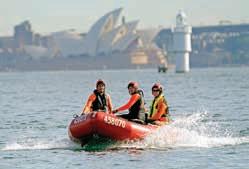
3 minute read
Have a whale of a time with the giants of the sea • How boaters can help entangled wildlife
Have a whale of a time with giants of the sea
Keep your distance from animals on the east coast migration highway.
Whale watching season is now well under way, with the giants of the sea on their annual migration north along the NSW coastline.
Boaters will be heading out in droves until the end of the season in December, hoping to get a glimpse of a whale or better still, a full-blown breaching, jumping, tail-slapping performance.
From June to August, the whales will be heading north to Queensland’s warmer climate and waters to breed and calve before then heading back south to Antarctica to feed between August and December.
Boaters out to watch whales must remember the rules in place for their own safety and that of the whales and other marine mammals they may encounter.
In a boat, whether powered or non-powered (such as a surfboard, surf ski or paddleboard), stay at least 100 metres away and 300m if there is a calf present.
Jet skis must stay 300m away at all times. Between 100m and 300m, you are required to travel at a constant slow speed and leave negligible wake. As you manoeuvre, watch the whales carefully to avoid disturbing or colliding with them.
Do not approach whales from behind or wait in front of them for their approach. If a whale approaches your vessel, do not move suddenly.
To protect yourself, your boat and the whale, slow your motors right
Do not disturb ... boaters must stay 100 metres from a whale and triple that distance if it has a calf with it. Photo: Brad Whittaker.
down and let the whale swim past you before moving away when it is safe to do so.
As a pod of whales may attract fellow onlookers, watch out for other boaters and keep a safe distance to avoid collisions.
How boaters can help entangled wildlife
What should boaters do if they spot a whale entangled in fishing lines, nets or other debris during migration season?
Marine Rescue TV spoke to an experienced whale disentanglement team from the NSW National Parks and Wildlife Service to find out.
Natasha Funke, from the Greater Sydney Branch of NPWS, said the first thing boaters should do if they spotted a whale in distress was to notify NPWS or ORCCA.
She said the NPWS had a highly experienced team that would head out, working with other agencies, to try to disentangle a whale caught in crab pots, shark nets or other fishing detritus.
“It’s really impprtant that you keep an eye on that animal for us,” she said. “That is the best job that you can possibly do, especially if you’re in a boat.
“That way, we can find you and we can then find the entangled whale. Please don’t try and disentangle it yourself. This is a very distressed animal.”
MRNSW crews commonly work with NPWS and ORCCA personnel to help free trapped whales.
“I have the privilege to be able to work with Marine Rescue volunteers,” Ms Funke said. “They’re there helping support us as the parent vessel, helping look after myself and my team and I really appreciate all of them who do come out to give up their time to help us out there on the water in this important operation.”
If you see a whale or dolphin that is sick, injured or caught in netting or other debris, call the ORRCA rescue hotline on 9415 3333.
Learn more about safe boating around whales on Episode 8 of Marine Rescue TV on the MRNSW website or YouTube.

NPWS whale disentanglement team, John Lambert, Natasha Funke and Luke McSweeney, on Sydney Harbour. Photo: Brian Roberts.










